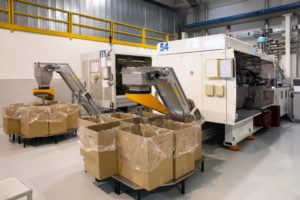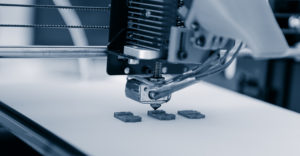Intro
Injection molding and 3D printing are the reigning champions of fabricating parts out of plastic. Plenty of machine shops offer one or both of these, but how are you supposed to know which one to use? More specifically, which one is more affordable? The answer changes based on your step in the production process.
In this guide, we’ll break it down. We’ll explain both technologies, and present three production scenarios. We’ll include math and give real-life examples to explain the cost comparison between injection molding and 3D printing.
What Is Injection Molding?
Injection molding machines use a metal mold with a cavity in it. The machine will fill the cavity with molten plastic, allow it to cool and harden, then open the mold and push the part out before repeating the process.

Injection molding is a very fast operation. If you watch one of these machines run, it might pop out a finished part every minute or so.
The downside is that the tooling is very expensive. The mold needs to be precise, durable, line up perfectly, and factor in a ton of different variables. However, the material used is typically very inexpensive — sometimes as low as $1 per lb used.
The material for one unit might cost less than a cent, but the tooling and mold could cost $10,000.
It breaks down to a matter of math. If you just make one part, then that unit costs $10,000.01. As the number gets bigger, the cost of the upfront tooling starts to dilute until you have a more competitive per-unit cost. Say you make 100,000 parts with the same mold, now the per-unit cost is $0.11.
This huge shift in per-unit costs is universal for injection molding operations. Basically, the more units you make, the more money you save per unit.
Explaining 3D Printing

3D printing is a mostly hands-off operation where a machine will lay down layer after layer of material. It builds up until the final part is made, then an operator will take the part out of the 3D printer and start the next one.
The material doesn’t cost a lot, but it might take a few hours to create a single part. During that time, the machine is tied up and can’t be used for other parts.
In general, the per-unit cost of a 3D-printed part doesn’t change as you go to larger quantities. The physical time and material to make the parts will be unchanging, so it’s just the shipping and logistics costs that might vary the price a little. In other words, a 3D-printed part will have the same per-unit part regardless of if you make 1 or 1 million units.
Which Option Is Less Expensive?
Now, let’s talk about money. 3D printing and injection molding can both create similar-looking parts that function the same, but there can be a tremendous difference in price. In general, there isn’t one option that’s always less expensive than the other. Instead, let’s look at three scenarios and see which option is less expensive in each scenario.
For this example, here’s the math we’re going to use:
- Each 3D printed part is $100 (material cost, shipping, and operational costs)
- The injection molding tooling costs $10,000
- The injection molded part costs $0.05 in material for each print
For Prototypes
Prototyping is a unique phase that most products will go through at some point. It involves making a part, testing it, tweaking the design, and making another one.
Prototyping is great for proving the concepts of your part, doing some destructive testing, checking the fit within your operation, and having a physical model to show stakeholders to get their buy-in.
A downside of prototyping is that it’s a volatile stage of development. You might go through ten different iterations of your product’s design during the prototyping phase.
As a result, you need a manufacturing process that can adapt and create parts with each new design as you iterate. Injection molding forces you to lock in your design before making any parts, so it won’t work here. It’s too early in your process for injection molding to be considered.
3D printing, on the other hand, is more versatile and can create each iteration in succession without extra costs. Let’s assume you go through four iterations of the design before moving to the next step.
- 3D printing per-unit cost: $100
- Injection molding per-unit cost: $10,000.05
Less expensive option: 3D printing
For Less Than 50 Units
Now, your prototype is perfect. You want to get started with a small batch of parts to see how the market responds or to do larger-scale testing. Alternatively, maybe you want some parts to try in your process to see if they actually work.
In this stage of development, you might order 50 units or less to do the things we just mentioned.
For this intermediate step, 3D printing still comes up ahead. Since it’s still a small batch run, you aren’t able to dilute the big upfront cost of injection molding tooling yet. This will translate to a much higher per-unit cost — especially compared to 3D printing.
- 3D printing per-unit cost: $100
- Injection molding per-unit cost: $200.05
Less expensive option: 3D printing
For High-Volume Production
Your product was a huge success, and now everyone wants one for themselves. As a result, you need to transition into full-scale production and deliver 100,000 units by the end of the year.
In this final phase of production, the per-unit cost of injection molding starts to be very impressive. You’ll see in the math below that the difference is massive.
In this step, there’s a good chance that a 3D printing operation can’t even keep up. It will still take hours to make each part, versus the minutes that an injection molder takes per part. Now it’s time to transition to injection molding your product.
- 3D printing per-unit cost: $100
- Injection molding per-unit cost: $0.15
Less expensive option: Injection molding
Conclusion
When you work with smaller scales, 3D printing is typically the less expensive per-unit option. As you move towards full-scale production, then injection molding can be significantly less expensive. If you want to try either fabrication option for your project, reach out to Rapid Axis. We offer full-scale injection molding and prototype 3D printing services.

